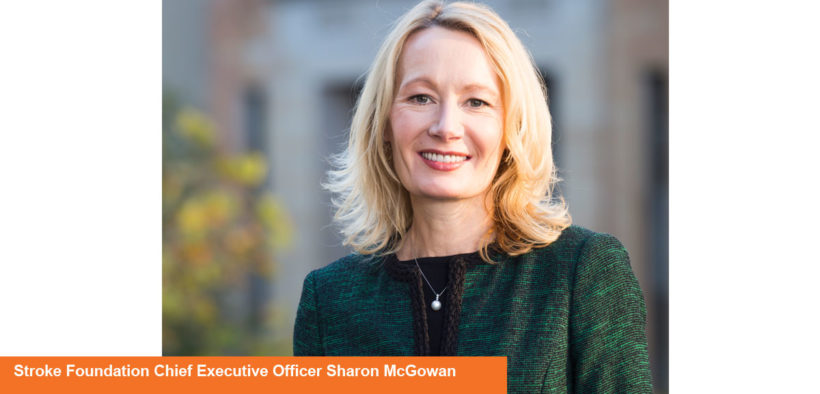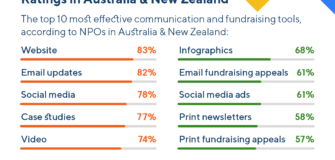This November, Stroke Foundation is challenging the community to get moving, reducing their risk of stroke and raising funds to support stroke survivors through a national campaign called Stride4Stroke.
Stroke Foundation Chief Executive Officer Sharon McGowan talked to Third Sector about the challenges in her environment, and how listening became a primary tool in making key decisions in health promotion and fundraising.
You are experienced in communications, community engagement, health promotion, people management and fundraising. What in these aspects has been greatly beneficial for your organisation?
As a Chief Executive Officer for a charity I am working in a challenging environment. All these skills are important parts of my tool box. Every day I utilise these skills in making decisions, but one of the key things I have learned in this role is to listen. I am also surrounded by a strong, skilled and passionate executive team and board. I work with some of the most amazing stroke survivors and volunteers and together we support our mission to prevent stroke, save lives and enhance recovery.
What attracted you to become part of The Stroke Foundation?
The Stroke Foundation is an incredible organisation with a very clear mission – to prevent stroke, save lives and enhance recovery. It is an honour to lead a team of passionate individuals who live and breathe those goals.
Stroke is one Australia’s biggest killers and a leading cause of disability. Having seen first–hand the devasting impact of stroke on a close family member, I know it can change lives in an instant, not just for the survivor but also for their loved ones. The good news is it does not have to be that way. Treatment for stroke has advanced so much in recent decades and if people with stroke get the right treatment at the right time, they can recover.
While I am encouraged by the developments in acute treatment, we still have a long way to go to ensure all Australians understand what a stroke is, know the warning signs (the F.A.S.T. message Face. Arms. Speech. Time) and know how to prevent a stroke. I am passionate about bringing government, health professionals and the broader community together to ensure reducing the impact of stroke becomes a major health priority and that everyone has access to best practice treatment, care and follow-up, no matter where they live.
In the 3 years you have been CEO, can you site a particular incident that made a big impact in your role/life?
There are many moments that have had a huge impact. These include partnering with the Royal Melbourne Hospital and Ambulance Victoria to launch Australia’s first a Stroke Ambulance (Mobile Stroke Unit) in Melbourne, securing Federal Government funding to produce the world’s first “living” guidelines for stroke management, the growth of our Australia’s Biggest Blood Pressure Check campaign and our volunteer StrokeSafe speaker program, and finally, our current development of Australia’s first evidenced–based national resource for families of childhood stroke survivors.
Personally, the biggest impact has been working with stroke survivors and their families and listening to their experiences. I have been so moved by the many, many inspirational and generous stroke survivors who want to make a difference and improve treatment and care for others in the future. Whether they have joined Team Stroke as a volunteer, shared their personal stories with their local politician or the media or interacted with each other on our social media platforms. Survivors, families and carers impacted by stroke are at the heart of every decision we make at the Stroke Foundation.
How has being a registered nurse helped your role?
As a nurse who trained in the 1980s, I have seen how far we have come in the diagnosis and treatment of stroke. But for those who do not receive treatment in time, the impact on families is just as devastating as it was 30 years ago. My nursing career provided me with a greater understanding that no two strokes are the same and that people can continue to recover over long period of time, if they are supported and given access to ongoing rehabilitation beyond their time in hospital.
What significant developments has made a real difference in support to make stroke a major health priority?
Increasing the profile of stroke as a major health issue and encouraging more government investment to tackle this disease is an ongoing challenge. However, we have recently partnered with the Heart Foundation, clinicians, researchers and survivors to develop a National Heart Disease and Stroke Action Plan. The first plan of its kind, it focuses on the prevention, control and research of heart disease and stroke. This plan brings the clinical evidence gathered over previous decades with the lived experience of those impacted by heart disease and stroke and provides governments with a roadmap of actions we can take together to improve the state of stroke in this country.
Funded by the Federal Government, the Action Plan demonstrates Government’s increasing commitment to reducing the impact and cost of heart disease and stroke on the Australian population now and in the future.
How important is increasing awareness of stroke for you?
Too many Australian lives are still being impacted by stroke. There will be more than 56,000 strokes in Australia this year and almost half a million stroke survivors are living in our community. Frighteningly, the number of strokes continues to rise as our population grows and ages and lifestyles become more sedentary.
Therefore, stroke prevention is so important. Research tells us more than 80 percent of strokes are preventable by keeping your blood pressure, cholesterol and body weight in a healthy range and maintaining an active lifestyle. If we can reduce the number of people having strokes in the first instance, it will reduce the burden on families, our community, the health system and the Australian economy.
What are the next steps for your organisation?
We are in the second year of our strategic plan Strategy 2022. Strategy 2022 sets out five clear strategic goals towards our mission of preventing stroke, saving lives and enhanced recovery. These goals were reflected in the National Action Plan for Heart and Stroke.
Much of our charity’s focus will be on gaining support to implement the actions and achieve goals of Strategy 2022, including fewer preventable strokes in Australia, ensure all Australians have access to the best evidence-based stroke treatment, enhance recovery to help Australians lives well after stroke, champion research in stroke, and grow our impact and manage our charity effectively and efficiently.
We believe that the National Action Plan for Heart Disease and Stroke provides a clear roadmap to tackling two of Australia’s biggest killers and we look forward to working with governments, the community and our supporters to deliver a better future for all.
Pearl Dy is a community manager and journalist. She is passionate about business and development particularly involving not-for-profits, charity and social entrepreneurship.























































































































































